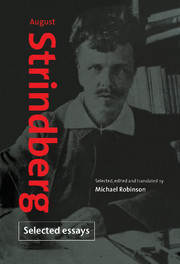Book contents
- Frontmatter
- Contents
- Notes on the text
- Introduction
- from Vivisections (1887)
- ‘On Modern Drama and Modern Theatre’ (1889)
- from Vivisections II (1894)
- ‘Césarine’ (1894)
- ‘Deranged Sensations’ (1894)
- ‘In the Cemetery’ (1896)
- from Jardin des Plantes (1896)
- ‘Introduction’
- ‘The Death's Head Moth’
- ‘Indigo and the Line of Copper’
- ‘To the Heckler’
- ‘On the Action of Light in Photography’ (1896)
- ‘A Glance into Space’ (1896)
- ‘Edvard Munch's Exhibition’ (1896)
- ‘The Synthesis of Gold’ (1896)
- ‘Contemporary Gold-Making’ (1896)
- ‘The Sunflower’ (1896)
- ‘The Mysticism of World History’ (1903)
- ‘August Strindberg on Himself’ (1909)
- Notes and commentary
- Index
‘The Death's Head Moth’
An Experiment in Rational Mysticism
Published online by Cambridge University Press: 18 December 2009
- Frontmatter
- Contents
- Notes on the text
- Introduction
- from Vivisections (1887)
- ‘On Modern Drama and Modern Theatre’ (1889)
- from Vivisections II (1894)
- ‘Césarine’ (1894)
- ‘Deranged Sensations’ (1894)
- ‘In the Cemetery’ (1896)
- from Jardin des Plantes (1896)
- ‘Introduction’
- ‘The Death's Head Moth’
- ‘Indigo and the Line of Copper’
- ‘To the Heckler’
- ‘On the Action of Light in Photography’ (1896)
- ‘A Glance into Space’ (1896)
- ‘Edvard Munch's Exhibition’ (1896)
- ‘The Synthesis of Gold’ (1896)
- ‘Contemporary Gold-Making’ (1896)
- ‘The Sunflower’ (1896)
- ‘The Mysticism of World History’ (1903)
- ‘August Strindberg on Himself’ (1909)
- Notes and commentary
- Index
Summary
The bleak, which lives at the water's edge and looks the sun in the eye, is silvery white and has only one bluish-green streak down its back. The roach, which keeps to shallow water, already has more pronounced colouring, and is sea-green. The perch, which is confined to deep water with a stony bottom, is already darker, and the lines down its back are black like the outline of the waves on its sides. The tench and the flounder which grub around in the mud have become as dark as the olive-green mud itself. The mackerel bears the marks of the billows so clearly outlined on its back that a marine painter might copy them and present them in perspective on a canvas to give the appearance of waves. But the golden mackerel which dwells in the crests of the waves has all the colours of the rainbow, with gold and silver as well.
What is this but photography? On its silver plate, which can be either silver chloride, silver bromine or iodyrite, since seawater is believed to contain all three halogens or, on its albumen or gelatine plate, which is silvered, the fish catches the colours refracted through the water. Since it lives and moves in the developer, in magnesium sulphate (iron) for example, the effect in statu nascent will be so powerful that colour photography is accomplished directly. And the fixer, or natrium hyposulphite, should not be that remote for a fish that lives in sodium chloride and salt sulphates, and which also carries its own supply of sulphur.
- Type
- Chapter
- Information
- August Strindberg: Selected Essays , pp. 149 - 154Publisher: Cambridge University PressPrint publication year: 1996



